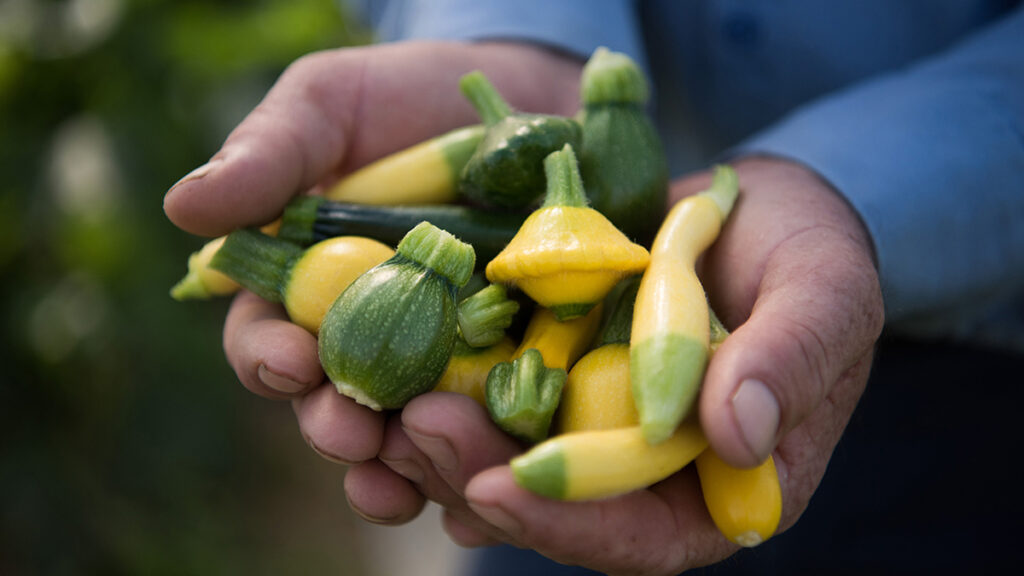July's Veg of the Month: Summer Squash
It's the vegetable that made Chef's Garden the cream of the crop.
Jun 22, 2023
Most folks give thanks to having their family or their health. The Jones family — family and health notwithstanding — gives thanks to the summer squash.
After losing the farm and having to start over, Farmer Lee Jones met chef Iris Bailin Broudy, who was looking for summer squash at a farmers market more than 40 years ago.
"Iris was searching for baby zucchini with squash bloom — we hadn't heard of cooking with the blossom in the '80s," Farmer Lee explains. He told his father, and soon, instead of throwing them out, the Joneses sold the blossoms on the plant to Iris.
Today, The Chef's Garden grows an array of beautiful summer squash varietals that range from the squat, flying saucer-shaped pattypan squash to the long, narrow, eye-catching Zephyr zucchini — a yellow squash with a light green bottom and stem, and a hint of green almond flavor.

What makes The Chef's Garden summer squash special?
"Summer squash allowed us to get a foothold in agriculture," Farmer Jones says. "It's a vegetable close to my heart because it made us look at other plants differently."
Before meeting Iris, Farmer Bob (Lee's dad) had grown only full-size squash. "During the summer season, we would pack our squash, sweet corn, cabbage, and peppers in 20-pound cartons, then load 10 semi-truck loads of produce to deliver to grocery stores," Farmer Lee recalls.
"After meeting Iris, we set our sights on flavor per mouthful rather than tons per acre — going through 100 different squash varieties before we arrived at the varieties we offer today."
Each squash varietal's thin, crisp skin covers a tender, juicy flesh with a mildly sweet flavor that comes either trumpet shaped, oblong, or like pattypan squash (“little flying saucers"). "They are truly some of the best-flavored squashes that exist anywhere in the world, and their individuality makes them worth having," Farmer Lee says proudly.
How to use summer squash
Summer squash is great for grilling and enjoying with a hamburger or steak, but Farmer Lee also suggests making these juicy and tender vegetables the star of your cookouts. "We don't even miss meat dishes when summer squash is in season," he exclaims.
And they are versatile too: Add thinly sliced squash to an omelet or frittata, or grate zucchini and squeeze out the excess liquid to make savory zucchini and carrot muffins. Roast richly flavored yellow and green squash to serve with a zesty, herb-filled dip or dice and sauté squash for pasta primavera.
The pattypan squash varietal, whose name is just as whimsical as its taste and texture —creamy, round, baby squash with jagged edges — makes a beautiful side dish to accompany salmon or honey and balsamic roasted chicken. And for squash blossoms —the eatable flowers that bloom at the ends of zucchini and launched a whole new era for Farmer Lee and his family — fill their flowery, soft leaves with mozzarella or goat cheese, dredge them in a light batter, and gently pan fry until golden.
How to care for and store summer squash (and blossoms too!)
Since summer squash is smaller and has more tender skin than hard, winter squash varietals (i.e., acorn, butternut, kabocha), it requires refrigeration. Store it in the crisper drawer, where it lasts up to a week.
When buying squash, Farmer Lee says to look for firmness: "No soft spots, which will hasten spoilage." A squash's skin should be matte with a slight sheen; shiny skin can indicate under-ripeness or waxing.
Before using, wash the squash well and trim the ends. For delicate squash blossoms, store them in their packaging between 40 and 45 degrees; to clean, rinse gently under cold running water just before using.
"Every vegetable we grow has a story to tell," Farmer Lee says. "And summer squash represents the blossoming of our mission at Chef's Garden — we look forward to growing and eating it every summer."
.svg?q=70&width=384&auto=webp)






















